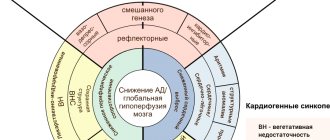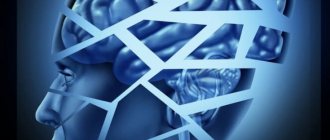We are accustomed to using the word “stress,” intuitively using it to denote strong neuropsychic tension. However, this meaning is not entirely correct.
The mechanism of stress was studied and described in detail by Hans Selye, and the term itself was introduced by Walter Cannon.
Stress is the body's general response to various factors (for example, shock, hypothermia, infection, death of a loved one, job loss) that disrupt its balance. The main function of stress is adaptation to changed environmental conditions.
Thus, the emotional reaction is only part of the body's overall response to a stressor.
Factors that cause stress can be absolutely anything - both negative and positive (wedding, moving, new job). All that matters is that they lead to changes in a person’s life at one level or another. It is typical for a person to have stressors of a psychological nature: stress is caused not by the situation itself, but by how a person subjectively evaluates and perceives it. Or even a fantasy, a memory of some situation.
Mechanism of stress
There are three main stages of stress:
- Mobilization stage. At this stage, the alarm reaction is activated. It mobilizes all the adaptive resources of the body and prepares it for urgent action. Energy exchange increases, heart rate increases, blood pressure rises, breathing quickens, digestion slows down, blood rushes to the muscles. In emergency situations, such as a fire, the alarm response can be very useful.
- Resistance stage. All body systems return to normal operation, and the development of new action programs (adaptation, adaptation to new circumstances) begins. The body has a certain reserve of resistance to stressors and adaptation.
- Exhaustion stage. In the case when the body was unable to adapt to new environmental conditions or develop a new program of action, resources are depleted. In this case, a person (and any organism) can get sick and even die.
Stages of stress
There are 3 stages or phases in the development of stress.
Alarm stage
It is characterized by pathological changes in the nervous, immune, cardiovascular, and digestive systems. Under the influence of a stressor, a rapid release of certain hormones occurs. This stage is relatively short-lived. If the stressor is removed, homeostasis is restored. As a result, everything passes without negative consequences, one might even say, without a trace.
But if the force of the stressor is great, death is possible already at this stage. Examples include death from hypothermia, massive trauma and extensive burns. Excessive emotional shocks with initially poor health also lead to a fatal outcome.
True, such unfavorable stress variants are rarely observed. In most cases, with the continued influence of the stressor, negative changes move to the next stage.
Stage of resistance or resistance
If the stressor continues to act, the body mobilizes all its reserves. Metabolism accelerates, physiological processes proceed more intensely. The goal of all these changes is to restore disturbed homeostasis.
Ultimately, adaptation to unfavorable conditions occurs - organ systems function in their original mode.
And even negative emotions disappear, or at least become less pronounced. This stage can take a long time. The compensatory and adaptive capabilities of the body are great, but not unlimited. And if the stressor does not stop, the next, final stage develops.
Exhaustion stage
Reserves are depleted and adaptation fails. At this stage, psychosomatic pathology is formed - the development of chronic non-infectious (somatic) diseases against the background of psychological disorders. Unlike the two previous stages, stress exhaustion is irreversible.
And even if the stressor stops acting, somatic diseases do not go away. And with the continued influence of stress factors, they progress and lead to death.
Mental status is characterized by emotional instability and severe depression. In rare, severe situations, it is even possible to develop mental illnesses that require treatment from a psychiatrist. In any case, at this stage it is impossible to get rid of the effects of stress and fully recover without outside help.
Mechanism of stress
Changes due to stress affect:
- nervous system
- endocrine system
- immune system
- metabolism (metabolism)
- condition and function of internal organs.
The sympathoadrenal system plays an important role in the development of stress reactions. It includes::
- structural elements of the CNS (central nervous system) - reticular formation, hypothalamus and pituitary gland
- sympathetic part of the autonomic nervous system
- adrenal medulla.
Its influence on processes, incl. and in response to stress, the sympathoadrenal system acts through catecholamines - adrenaline and norepinephrine. Most of the hormone adrenaline is produced by the adrenal medulla. And norepinephrine is the main sympathetic neurotransmitter.
When exposed to stress, the reticular formation and hypothalamus are activated. If the stressor is of a psychogenic nature, i.e., associated with negative emotions, the hypothalamus is activated from the cerebral cortex. Next, the reticular formation and hypothalamus activate the sympathetic nervous system. Under the influence of sympathetic impulses, the production of adrenaline by the adrenal glands increases.
The sympathoadrenal system is anatomically and functionally connected with the hypothalamic-pituitary-adrenal system. Thus, in extreme situations, the hypothalamus, through the release of corticotropic hormone, stimulates the pituitary gland to produce adrenocorticotropic hormone (ACTH).
In turn, ACTH enhances the production of corticosteroid hormones (hydrocortisone and cortisone) by the adrenal cortex. In their action, corticosteroids are in many ways similar to catecholamines, but their ratio is different.
With strong negative emotions (irritation, rage), the sympathetic nervous system is activated and a lot of norepinephrine is released. Under the influence of external unfavorable factors, the production of adrenaline by the adrenal glands increases to a greater extent.
Manifestations of stress
The main physiological effects of catecholamines:
- dilated pupils (mydriasis)
- increase in heart rate (HR) and their strength
- spasm of small arteries (arterioles), and, as a result, increased blood pressure
- bronchial dilatation
- inhibition of the secretion of salivary and digestive glands, reduction in the formation of gastric and intestinal juices
- relaxation of smooth muscles of the gastrointestinal tract, inhibition of intestinal motility
- increased blood sugar (hyperglycemia)
- breakdown of fats (lipolysis).
All these effects arose for a reason. They have a certain meaning, and in some situations they can be beneficial, and even help save life. The sympathoadrenal system is a product of evolution. It was formed over a long period of time.
Prehistoric animals and our ape-like ancestors experienced stress when they hunted, hid from predators, or competed with each other for prey. At the same time, the main types of stress behavioral reactions were formed:
- Strike first to take loot or destroy an enemy.
- Hide, remain unnoticed, escape the conflict.
- Run away and thereby be saved.
Which behavior option to choose depends on personality traits, the nature of the danger, the specific situation, and much more. But, in any case, stressful physiological changes help to cope with danger.
Dilation of the pupils during stress helps you see better in the dark and examine distant objects. All this allows you to notice the danger in time. After all, the wider the pupil, the more visual information is projected onto the retina. With mydriasis, when the dilated pupil occupies most of the iris, the entire eye appears enlarged. This is probably where the famous saying comes from: fear has big eyes.
In order to overtake an object or hide from it yourself, you need physical strength and endurance. And for this, in turn, energy is needed. Energy is generated during the breakdown of glucose. The source of glucose is glycogen in the muscles. Increased breakdown of glycogen is accompanied by hyperglycemia - an increase in glucose in the blood plasma.
Another source of energy is fats and fat-like substances (lipids). These are also high-energy compounds. Some of the lipids, along with amino acids, are used for gluconeogenesis - the synthesis of glucose, necessary in extreme situations.
But in order for metabolic processes to proceed at an accelerated pace during stress, and for muscles to cope with the increased load, adequate blood circulation is needed. The stronger and more often the heart contracts, the greater the amount of blood flows through the vessels. Arterial spasm and increased blood pressure promote better blood supply to muscles and other tissues.
Spasm of cerebral or cerebral vessels to a certain extent improves blood supply to the brain. Thanks to this, feelings are heightened. During times of stress, not only vision improves, but also hearing and smell. Attention and thinking are stimulated. All this helps to better analyze the environment.
Norepinephrine, unlike adrenaline, spasms arterioles more strongly. With its massive release, a strong spasm of cerebral vessels leads to the opposite effect. With strong fear or anger, adequate perception of the environment is disrupted.
Therefore, people in a state of passion often commit uncontrollable actions that are difficult to explain logically. In order to saturate the blood with oxygen during stress, you need to increase its supply from the outside. For this purpose, breathing quickens and the lumen of the bronchi expands.
The sympathoadrenal system has a negative effect on digestion - peristalsis (wave-like contractions of smooth muscles) of the intestine slows down, and the volume of digestive juices decreases. And this is also justified under stress. Energy consumption for digestion and absorption of food components is an unaffordable luxury in times of danger. And therefore, under stress, there is no appetite.
And in times of great danger, due to relaxation of the smooth muscles of the intestines, embarrassment may occur in the form of involuntary bowel movements (“shit out of fear”). A similar embarrassment is uncontrolled urination. And, oddly enough, this also has some meaning. At a critical moment, in order to develop greater speed, the body strives to reduce mass as much as possible, and at the same time get rid of ballast.
Another luxury is libido. In extreme situations, it is advisable to postpone infatuation with the opposite sex for the purpose of pleasure and reproduction until better times. Therefore, in men, due to vascular spasm, the filling of the cavernous bodies with blood worsens, which makes an erection impossible. In women, decreased blood flow to the genitals also does not promote sexuality.
All these protective-adaptive reactions are justified only in stage I of stress and anxiety. And during stages II-III of resistance and exhaustion, when the production of catecholamines increases and then sharply decreases, these reactions acquire pathological features. Negative changes are formed in all vital systems of the body.
Metabolism
Adrenaline is a counter-insular hormone. Its action is opposite to that of insulin. If insulin lowers blood glucose levels, adrenaline, on the contrary, increases it. This is achieved through the breakdown of glycogen and glyconeogenesis, the synthesis of glucose from lipids and amino acids.
Corticosteroids released in large quantities during stress also have a counter-insular effect. At first, the increase in blood sugar levels is compensated by increased insulin production. But eventually, insulin reserves in the pancreas are depleted, and diabetes develops.
With prolonged intense stress loads, glucose is also depleted. Its deficiency (hypoglycemia) is incompatible with life. To cover energy costs, lipids are released into the blood along with glucose. Some lipids in the form of low-density cholesterol are deposited on the walls of blood vessels, developing atherosclerosis.
In addition, during the breakdown of glucose and lipids, intermediate compounds, so-called ketone bodies (this includes acetone), are formed in excess. Ketone bodies have a general toxic effect and poison the liver, kidneys and brain.
Antioxidant system
Under the influence of catecholamines, reactive oxygen species are formed in the form of the so-called. free radicals. Unlike usual, free radical oxygen atoms have an additional electron in the outer orbit. Because of this, the free radical has increased reactivity.
Under stress, they are designed to speed up metabolism, ensure cell growth and division for tissue repair. The excess of these particles is neutralized by the antioxidant system, consisting of components of the immune system, vitamins, and other biologically active substances. But under stress, so many of them are formed that antioxidants cannot cope with them.
As a result, free radicals damage the lipids of cell membranes. Massive cell death leads to tissue damage. This is one of the mechanisms of non-infectious inflammation triggered by free radical oxidation. In addition to membranes, free radical oxidation also damages DNA.
Changes in the genetic apparatus lead to the appearance of cells with atypical properties. Some of them are sources of tumor tumors. All these pathological changes caused by the action of free radicals are figuratively called the body’s payment for adaptation.
The cardiovascular system
Persistent spasm of arterioles triggers hypertension. In combination with vascular atherosclerosis, hypertension increases the risk of myocardial infarction and cerebral stroke.
Free radical damage to blood vessels aggravates atherosclerosis and contributes to the formation of dystrophic processes. As a result, myocardial contractility decreases, and heart failure develops. Damage to the conduction system of the heart leads to the development of arrhythmias.
The immune system
In the anxiety phase, under the influence of catecholamines, a physiological decrease in immunity is noted. This reduces the risk of allergic reactions, but increases susceptibility to bacterial and viral infections.
In the next stage of resistance, the body comes to its senses. And in the final stage, oppression, the protective forces are disrupted. This can cause not only infectious, but also somatic diseases. This increases the risk of malignant neoplasms.
Blood
Changes in the blood picture are varied and depend not only on the stage of stress, but also on the nature of the stressor. At first, the production of leukocytes and erythrocytes by the bone marrow increases. Although eosinophils and lymphocytes are initially suppressed.
This is one of the mechanisms for reducing immunity and reducing the risk of allergies during the alarm phase. In resistance, red blood cell production may increase or decrease. Corticosteroids released during stress harm hematopoiesis. In exhaustion, depression of all blood cells is noted.
Gastrointestinal tract
The effect of stress on the gastrointestinal tract leads to a persistent decrease or absence of appetite. Problems with digestive function with long-term problems are accompanied by emaciation, nutritional deficiencies, and chronic gastrointestinal diseases. If stress is caused by starvation, then all these disorders are primary.
A stress ulcer of the stomach or duodenum (stress ulcer) often develops. It is characteristic that peptic ulcer disease can form both under a stressor and after its effect ceases. And it is not caused by lack of appetite or starvation. The nutritional factor does not play any role here.
Under the influence of catecholamines, the vessels of the gastric mucosa spasm. Here, zones of ischemia (insufficient blood supply) and then necrosis in the form of ulcerative defects are formed. In case of burns, massive injuries, and some serious diseases, increased protein consumption occurs, leading to its deficiency.
Due to protein deficiency, the barrier function of the gastric mucosa is reduced, and this predisposes to the formation of ulcers. If the stressor stops acting, parasympathetic activity replaces sympathetic activity.
Under the influence of its impulses, gastric peristalsis increases, the volume of gastric juice secreted increases, and its acidity increases. As a result, hydrochloric acid corrodes previously ischemic areas of the mucosa.
Endocrine system
Sympathoadrenal activation inhibits the release of many hormones, incl. thyroid, genital, somatotropic. Thyroid dysfunction aggravates metabolic disorders under stress. Somatotropic hormone promotes protein synthesis, and in childhood and adolescence stimulates growth. Therefore, its inhibition during stress in children slows down growth, and in later life causes protein deficiency.
Slow testosterone production combined with vascular spasm in the penis leads to persistent erectile dysfunction. In women, the menstrual cycle is disrupted. In both sexes, libido decreases and infertility develops.
Impact of stress
Under stress, hormonal changes occur in the body, which regulate the functioning of all body systems and cause the activation of resistance resources. Stress mechanisms involve, in particular, the subcortical parts of the brain, which are also responsible for emotions. Thus, during times of stress, one of the most typical emotional states is anxiety and worry. .
As a result of the action of neuroendocrine stress mechanisms, the so-called triad is formed: proliferation of the adrenal cortex, reduction of the thymus gland and gastric ulceration. These reactions can be easily compared with symptoms characteristic of almost any disease, such as a feeling of malaise, diffuse pain and aching sensations in the joints and muscles, gastrointestinal disorders with loss of appetite and loss of body weight.
Thus, severe or chronic stress is the basis for the occurrence of psychosomatic diseases .
Benefits from stress
Exposure to mild stressors is somewhat beneficial. Firstly, mild short-term stress helps to activate resources and mobilize to perform a specific task (for example, to pass an exam). Secondly, with each stress, the psyche appears several new activity programs, that is, a person expands and replenishes his behavioral “repertoire” with new ways of interacting with the outside world, and increases self-confidence with each obstacle overcome. The natural need for renewal of emotions is saturated. It is important that the body has enough reserves to adapt.
Help from a psychologist for stress
A psychologist’s help with stress can be used in two ways:
- If any new situation is stressful for you. You often experience a state of causeless anxiety, are depressed, irritable, depressed in the absence of objective reasons. For you, there are a large number of stress factors of psychological origin. Stress is not caused by objective reasons, but by your subjective assessment of what is happening, expectation of the worst consequences, etc. In this case, sessions with a psychologist will help change your assessment of what is happening and reduce the amount of stress of psychological origin.
- Neutralizing the effects of stress. Classes with a psychologist in this direction will help if you have already experienced severe stress , your energy reserves have been depleted, and you feel the need to recover. It is also important to work through and understand the emotional causes of the psychosomatic illness that has arisen in order to prevent its further development.
Amber Center specialists have experience in successfully working with the causes and consequences of stress. After a psychological diagnosis, a psychologist (psychotherapist) will develop an individual training route and, if necessary, give exercises for independent work at home.
Make an appointment with a specialist by calling (812) 642-47-02 or fill out the application form on the website.
What is stress?
In everyday life, this term refers to a whole range of experiences that a person experiences when finding himself in a traumatic situation. But first of all, stress is a reaction of the body
to changing environmental conditions. Which allows a person to adapt to conditions.
We can say that life is a constant series of stresses. And a person's behavior partly depends on how intense they are. Mild stress
serve as shakes and help a person become more energetic, active and collected.
Moderate stress
can affect mental performance and make a person distracted and hot-tempered.
And severe stress
leads to apathy and loss of strength.
Give yourself life: dealing with stress
How to recognize the signs of upcoming stress and deal with it? Evgenia Otradnaya, Evgenia Dobrovolskaya and our experts tell the story.








